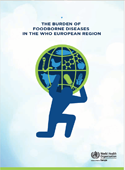The burden of foodborne diseases in the WHO European Region (2017)

Download
The first estimates of the global and regional burden of foodborne disease, published by WHO in December 2015, show that the burden is significant throughout the world. This report presents data for the WHO European Region. Every year, more than 23 million people fall ill from eating contaminated food, resulting in 5000 deaths and more than 400 000 disability-adjusted life years. The most frequent causes of foodborne disease are diarrhoeal disease agents, the most common being Norovirus followed by Campylobacter spp. Non-typhoidal Salmonella spp. are responsible for the majority of deaths. Non-typhoidal Salmonella spp. followed by Campylobacter spp. cause the highest burden; the parasitic disease toxoplasmosis, which can cause severe damage to unborn children and immunodeficient patients, represents the third highest burden of foodborne disease. These figures indicate the need for strengthened prevention, surveillance and management of foodborne disease in the European Region, including risk communication, awareness-raising and consumer education. Furthermore, the data can be used to guide food safety policy-making and decision-making, including prioritization, at national and regional levels. WHO is committed to working with its Member States and partners to strengthen prevention, detection and management of food safety risks, with the overall aim of lowering the burden of foodborne disease.



